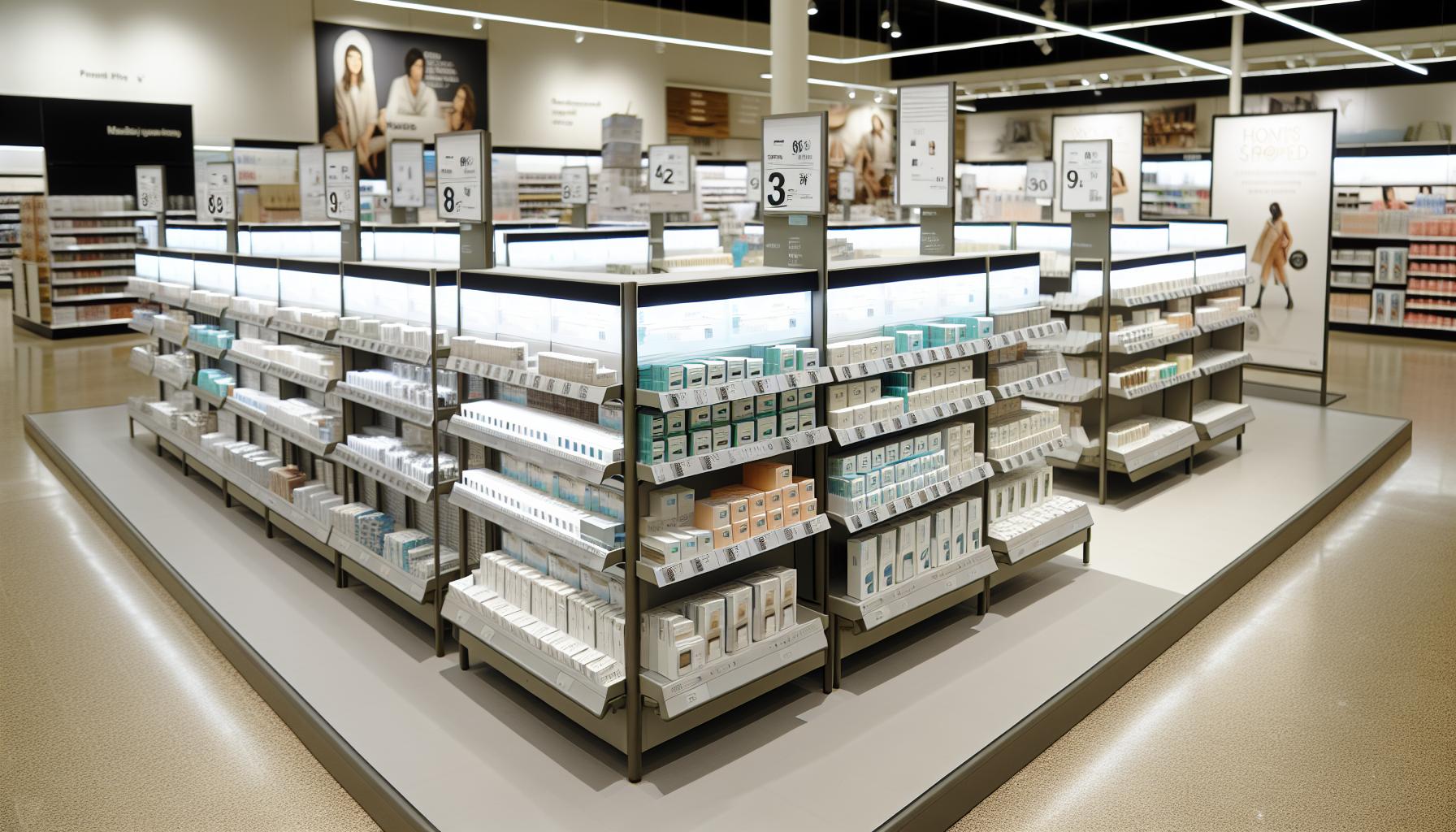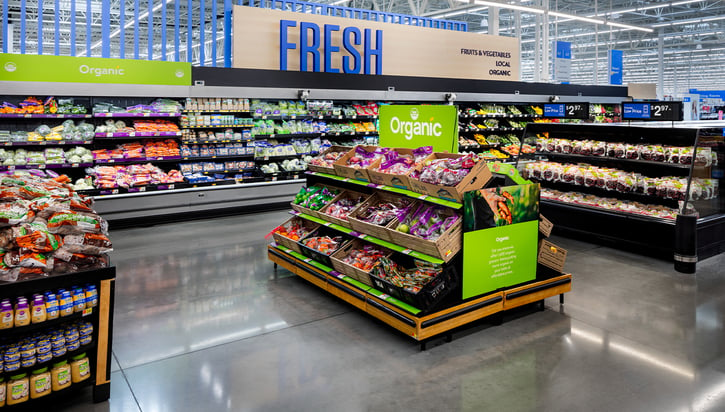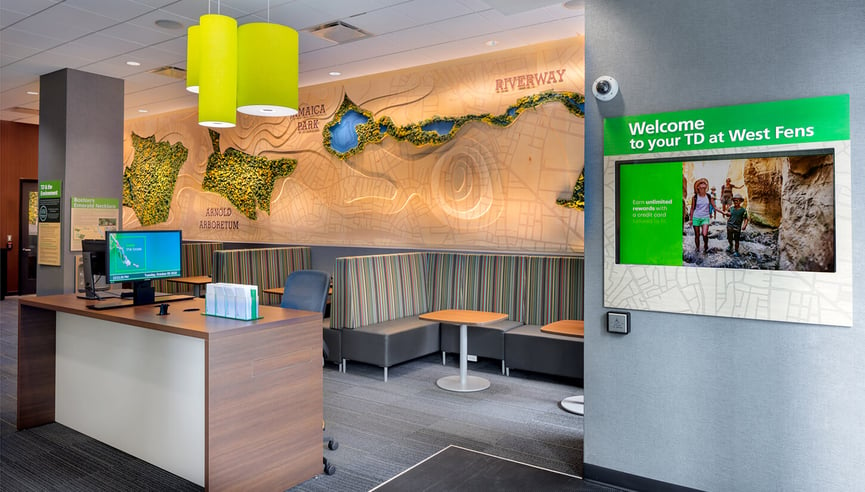Sustainable Interior Design for Branded Environments
When it comes to physical spaces — stores or banks — there will always be waste.
Pursuing sustainable interior design can not only reduce your environmental impact but also demonstrate your commitment to responsible stewardship, fostering loyalty among your customers and clients.
In honor of Earth Day, we’re sharing our top waste reduction strategies that can be easily applied to any brand environment.
Design for durability
We couldn’t call ourselves a branded environments company without first discussing design. Designing branded elements for durability and repurposing is essential for waste reduction. By creating a space with longevity in mind, your company can minimize the need for frequent replacements, thereby reducing waste generation.
 Rendering of a retrofitted gondola for a store making it possible to see what the new parts may look like in a retail setting before the prototyping phase.
Rendering of a retrofitted gondola for a store making it possible to see what the new parts may look like in a retail setting before the prototyping phase.
Modular and adaptable designs offer versatility and allow branded elements to be easily repurposed or reconfigured as needed. For example, modular display systems can be rearranged to accommodate changes in product offerings or store layouts without requiring entirely new installations.
Miller Zell’s modular display systems offer versatility and flexibility, enabling retailers to effortlessly refresh their merchandising layouts to minimize waste. Similarly, our commitment to designing furniture with disassembly in mind ensures that products can be easily refurbished or repurposed at the end of their life cycle.
By embracing design principles that prioritize durability and flexibility, brands can extend the lifespan of their interior branding elements and minimize waste accumulation over time.
Sustainable interior design materials
So, what are Sustainable Interior Design Materials? They are materials that are durable, long-lasting and meant to stay out of the waste system for as long as possible.
Miller Zell recommends materials that are suited to the project, whether the material is recyclable or not. The reality is most recyclable materials are more expensive and not as durable. When used for a long-term project, they often fall apart faster, therefore requiring more material, creating a bigger carbon footprint and adding more to the waste pile.
The best way to get rid of waste is to not create any at all. The choice of materials and how they are used in a branded environment plays a significant role in determining environmental impact.
Here are some materials that are sustainable because of their recyclability and/or remanufacturing ability.
- Polystyrene: A long-lasting, durable, recyclable and affordable material. Often polystyrene signage is used for non-green reasons like its weight (light,) ability to be cut and the vividity of printed colors. (Note: These products cannot be recycled in residential bins. Please work with your manufacturer to find a removal system for old and broken pieces.)
- Foam core: There are many foam core board to choose from but ULB or UltraBoard is made with at least 30-50% recycled content.[1]
- Corrugated materials: This material is easily customizable to eliminate excess waste. It also reduces the material being wasted after usage by being entirely recyclable.
- Acrylics: Recrylic is a Certified Recycled Acrylic and an earth-friendly solution for sustainable retail + design.
By incorporating these eco-friendly materials into branded elements, such as signage, displays and fixtures, businesses can significantly reduce their reliance on finite resources and minimize waste generation.
Most emissions and waste occur within product supply chains rather than within branded environments, such as stores, banks and distribution centers. Signage offcuts and finishing waste is an issue, and how it’s handled by the company you work with is just as important as dealing with your own.
So here are a few questions you should ask your manufacturer and how Miller Zell would answer.
- What do you do with the offcuts/manufacturing waste (extra bits of material)?
- When the material is recyclable, we try to get it into the recycle stream. For example, we have a densifying process that recycles 40% of our raw materials waste.
- When the material is recyclable, we try to get it into the recycle stream. For example, we have a densifying process that recycles 40% of our raw materials waste.
- How engaged in the process can [your company] be?
- As much as you want! From the beginning of our relationship, our account managers will have life cycle conversations, sustainability and how your designs — through someone else or us — can have the most sustainable materials.
- As much as you want! From the beginning of our relationship, our account managers will have life cycle conversations, sustainability and how your designs — through someone else or us — can have the most sustainable materials.
- Do you have the data to show us how this all works?
- Yes, we have what we do on a high level listed here, and we can send all the other data directly to your inbox (privacy protected for clients). We also have a Sustainable Green Printing certification.
- Yes, we have what we do on a high level listed here, and we can send all the other data directly to your inbox (privacy protected for clients). We also have a Sustainable Green Printing certification.
- Do you talk about sustainability with your suppliers?
- We do!
- We do!
- What else does your company do to be sustainable?
- We have solar panels on our headquarters’ roof that produce over one million kwh annually. When you visit, our in-house cafeteria uses green and recycled products, and more.
So consider the entire life cycle of materials and products, from sourcing to disposal, to make informed decisions that minimize environmental impact and maximize durability.
Waste management and recycling programs
There’s a lot we can offer toward implementing effective waste management and recycling programs. These are crucial for minimizing landfill waste associated with interior branding activities.
Establishing clear protocols for waste segregation and disposal ensures that recyclable materials, such as paper, cardboard and plastics, are diverted from landfills and sent for proper recycling.
Collaborating with recycling facilities or organizations further enhances the effectiveness of waste management efforts.
Many recyclable materials can be used, but it’s a collaboration between your brand and third-party manufacturer. Your manufacturers should be able to recommend non-residential waste recyclers. By partnering with certified recyclers, branded environments can ensure that waste materials are processed responsibly. This contributes to a circular economy where resources are reused and recycled to minimize environmental impact.
Sustainable Interior Design Examples

Walmart | Walmart’s stream of sustainability extends to its manufacturing process for interior branding. As a supplier, Miller Zell prides itself on prioritizing using sustainable or recyclable materials that meet those standards. Additionally, we’ve accepted Walmart’s invitation to take action with Project Gigaton, their sustainability branch with the goal to reduce or avoid one billion metric tons (a gigaton) of greenhouse gases from the global value chain by 2030.

TD Bank | TD Bank commissioned Miller Zell to revamp a 50-foot wall in its Boston branch, emphasizing sustainability. Using only sustainable materials, our design team created the artwork, design, graphics, visual elements and lighting and took the lead on engineering and project management. This branch even won a Shop! Design Award.
So What?
Waste reduction strategies are integral for creating sustainable interior branding solutions. By carefully selecting materials, designing for durability and repurposing and implementing effective waste management programs, businesses can minimize their environmental footprint while creating visually appealing branded environments.
As consumers increasingly prioritize sustainability, brands that demonstrate a commitment to waste reduction and environmental stewardship stand to gain a competitive advantage.
By embracing sustainable practices in interior branding, businesses can not only enhance their brand image but also contribute to a healthier planet for future generations. These efforts translate into lower utility bills, reduced operating costs and decreased waste disposal expenses.
[1] Only one product is not made of 30-50% UltraBoard Core™